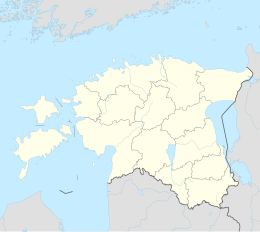Sindi (Estonia)
| Sindi | |||
|
|||
| State : |
|
||
| Circle : |
|
||
| Coordinates : | 58 ° 24 ' N , 24 ° 39' E | ||
| Height : | 14 m | ||
| Area : | 5.0 km² | ||
| Residents : | 3,845 (January 1, 2017) | ||
| Population density : | 769 inhabitants per km² | ||
| Time zone : | EET (UTC + 2) | ||
| Telephone code : | (+372) 44 | ||
| Postal code : | 86705 | ||
| Website : | |||
|
|
|||
Sindi ([ ˈsɪndi ], German Zintenhof ) is a town in the rural municipality of Tori in Pärnu County in western Estonia .
location
Sindi lies on the banks of the Pärnu River. The Lanksaare moor is in a plain near the city .
history
Sindi got its name around 1565 after the owner of the nearby manor house, Pärnu mayor Claus Zindt. The name Suria has been documented since 1601, and Zintenhof since 1638. At that time it consisted of six farms in addition to the manor house.
The actual place was founded in 1833 as a workers' settlement of a cloth factory. This was built by the Riga entrepreneur Johann Christoph Wöhrmann after his forerunner company in Poland was burned down during the unrest there in 1831. In the course of the 19th century, especially under the direction of Christian Heinrich von Wöhrmann , the economically prosperous factory was expanded. An ore processing part, candle production and a gas factory were added in 1857/58. Apartments, a hospital and three elementary schools were built.
With the population growth, Sindi received the status of a large village ( alevik ) in 1921 . In 1928 the place was connected to the railway network, which promoted population growth and economic success. In 1938 Sindi was granted city rights.
In 1939 the city was to get a new, Estonian name, which no longer reminds of the German-Baltic Zindt. However, the name was not renamed because of the Soviet occupation of Estonia in 1940.
In 2017, the previously independent city became part of the rural municipality of Tori.
Attractions
The train station built in 1927/28 and the town hall built between 1935 and 1937 are worth seeing in Sindi. In addition, the old factory buildings of the traditional cloth factory have been preserved.
In the Viira district on the Pärnu River, there was a Stone Age settlement of the Kunda culture , probably the oldest in Estonia. Settlement dates back to 7500 BC. Estimated. The site was uncovered during excavations in 1965.
people
- Julius Seljamaa (1883–1936), politician, diplomat and journalist
- Karl Tofer (1885–1942), diplomat
- Uno Palu (* 1933), athlete
- Allar Raja (* 1983), rower
literature
- Dirk-Gerd Erpenbeck: The skilled workers of the Zintenhof cloth factory in Estonia in the founding years 1833 to 1838 , in: Journal for East German Family History 58/2 (2010), pp. 33–46.
Web links
- Sindi Municipality website (Estonian)
proof
- ↑ Eesti Statistika , accessed on May 18, 2017







